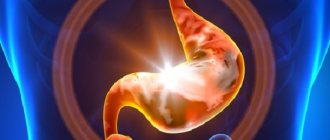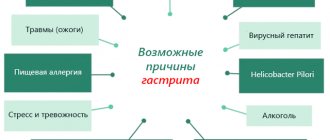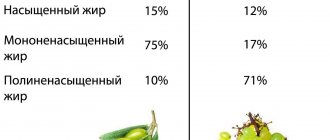Treatment of gastritis with high acidity
Treatment of gastritis with high acidity involves, first of all, a thorough preliminary examination. It includes:
- Ultrasound of the stomach;
- fibrogastroduodenoscopy;
- laboratory tests of blood, urine, feces, tissue samples and gastric secretions taken during FGDS;
- if necessary, consultation with other specialists (endocrinologist, hepatologist, immunologist, etc.).
During the diagnostic process, the doctor receives information about all aspects of the disease, including its type, causes of inflammation and excessive secretory function, the degree of damage to the gastric mucosa, and the presence of possible complications.
Only after receiving a complete picture of the disease does the doctor prescribe the treatment necessary in a particular situation. Drug therapy may include the use of a wide range of drugs, the action of which is aimed at eliminating infection, relieving inflammation, reducing the acidity of gastric juice, etc. - depending on the characteristics of a given clinical case.
Exacerbation of gastritis with high acidity requires separate symptomatic treatment - it is important to relieve pain, heartburn and other manifestations of the disease that reduce the patient’s quality of life.
It should be understood that treating gastritis with high acidity with medications is not enough: the patient himself is required to follow a number of recommendations regarding dietary correction, elimination of bad habits, etc. In combination with qualified medical care from gastroenterologists at our clinic, this will allow you to forget about the disease forever.
Modern methods for studying gastric secretion
Due to the clarification of the mechanisms of gastric secretion and the emergence of methods that allow long-term and continuous recording of pH in the esophagus, stomach and duodenum, the need arose to introduce them into the work of medical institutions in Russia.
| Long -term monitoring of pH in the upper parts of the digestive tract makes it possible to identify gastroesophageal and duodenogastric reflux, determine the acid-forming function of the stomach after surgical interventions on the stomach, and also provides the opportunity for individual selection of the dose and regimen of taking an antisecretory drug and monitoring the treatment. |
It is known that the production of hydrochloric acid is carried out by the parietal (parietal) cells of the body and fundus of the stomach. On the basolateral membrane of these cells there are histamine (H2) acetylcholine (M3) receptors, the stimulation of which stimulates the formation of hydrochloric acid.
Central and peripheral mechanisms are involved in the regulation of hydrochloric acid secretion in the stomach. The central mechanisms of stimulation of gastric secretion include activation of the vagus with the release of the mediator acetylcholine. The latter, by binding to the M3 receptors of parietal cells, stimulates the production of hydrochloric acid. Indirect acetylcholine stimulation of acid production, mediated by preganglionic vagal activation with the participation of M1 receptors, is also recognized. Activation of the vagus also promotes the release of gastrin and histamine in the gastric mucosa.
The action of local mechanisms for stimulating gastric secretion can be represented as follows: in response to food intake, which leads to alkalization of the stomach contents and the appearance of peptides in it, gastrin is produced by G-cells of the antrum. The latter, acting on the parietal cell, promotes the release of free calcium ions from intracellular stores and ultimately causes hyperproduction of hydrochloric acid.
To study gastric secretion and acidity, two main methods are used: aspiration-titration and intragastric pH-metry. The first method is based on aspiration of stomach contents using a thin probe, followed by titration of the resulting contents. In this case, the volume of secretion on an empty stomach and after stimulation, titrated acidity, acid and pepsin flow rate and other parameters are determined in order to study the functional state and potential capabilities of the secretory apparatus of the stomach. In practice, this method turned out to be insufficiently informative and difficult to standardize, and therefore a pH-metry method was proposed, which is based on determining the concentration of free hydrogen ions H+.
Equipment has been developed for long-term, continuous intracavitary pH monitoring. This method is the most physiological and accurate; it allows one to evaluate the effect of various factors affecting acid production (food intake, various medications, smoking).
In the process of studying the profile of 24-hour intragastric acidity in healthy people, a daily circadian rhythm of hydrochloric acid production was revealed and its significant changes in patients with chronic gastritis (antral, gastric body, pangastritis), duodenitis (anthropyloroduodenitis), peptic ulcer, reflux esophagitis. Based on this study, it is possible in most cases to differentiate autoimmune gastritis (up to achlorhydria as a result of atrophy of parietal cells) from Helicobacter gastritis. The latter never manifests itself as achlorhydria, since in this form of gastritis the atrophic process is focal in nature, and in antral gastritis, antropylorobulbitis, peptic ulcer with localization of the ulcer in the outlet of the stomach and in the duodenal bulb, the acid-producing function is usually increased, especially at night. In case of reflux esophagitis and insufficiency of the lower esophageal sphincter, using this method, reflux of acidic gastric contents is detected, and it is also possible to study the frequency and duration of refluxes. It is extremely important that this method allows one to evaluate the effect of various drugs on the intraesophageal and intragastric environment depending on the dose, route of administration and time of administration.
Currently, a clinical trial of the acidogastrometric automated complex AGM-24MP (“Gastroscan-24”) produced by Istok-System (Fryazino, Moscow Region) has been completed at the Federal Gastroenterological Center. The AGM-24 MP device is designed for continuous recording of pH values in the esophagus, stomach and duodenum for 24 hours with a reading interval every 20 seconds. The study is carried out using a pH probe inserted transnasally, connected to a secondary converter (AGM-24 MP acidogastrometer), with subsequent transfer of the data array for processing on a PC. At the end of the examination, information is provided in text and graphic modes about the dynamics of pH during the study. The obtained results are saved in the database. The AGM-24 MP acidogastrometer is a secondary converter that works with a pH probe. The acidogastrometer is made in a portable version (weight about 500 g) with autonomous power supply from batteries. This allows pH values to be recorded every 20 seconds for 24 hours. The device is equipped with a symbolic-digital indicator that allows you to control its operation. The presence of 15 keys allows you to both set the operating mode of the device (calibration, data reading, start and end of work), and mark various time intervals and events during the examination of the patient (eating, medications, pain, heartburn, etc.).
The pH probes used in this study consist of 2 mm diameter antimony measuring electrodes mounted in a 2.0 mm diameter polymer tube and an external silver chloride reference electrode. The probes have three main types: with one (G1), with two (G2) and three (G3) measuring electrodes. For patients of different age groups, the transducers are made with interelectrode distances of 50, 70, 90, 110 and 120 mm.
| To study gastric secretion and acidity, two main methods are used: aspiration-titration and intragastric pH-metry |
The software included in the Gastroscan-24 system is designed to run on an IBM PC-compatible PC in the MS–DOS operating system (version no lower than 3.2). The software package includes files with a database, files for conducting examinations, files with instructions for operating the complex, and demo files. This program allows you to analyze the data obtained over various time intervals and save research data in a database.
Also, SNPP “Istok-System” produces equipment for conducting traditional research of gastric secretion within two to five hours (“Gastroscan-5”, “Gastroscan”, “Gastrotest”, “AGM-03”), which can be used in the work of functional diagnostics, gastroenterological and surgical departments of hospitals, clinics and diagnostic centers, as well as in scientific research. These devices are equipped with pH probes, which have from one to five pH sensors with a diameter of 7 to 1.8 mm, which makes it possible to measure pH through the instrumental channel of the fiberscope.
In connection with the creation of modern equipment that makes it possible to accurately assess the acid-forming function of the stomach and evacuation disorders in diseases of the upper digestive tract, the possibilities for individual selection of optimal drug therapy have significantly expanded.
Advantages of contacting the First Family Clinic of St. Petersburg
Our goal is to restore your health using the most effective methods and means. A team of highly qualified specialists from various fields of medicine, the latest developments in the treatment of gastroenterological diseases, innovative diagnostic equipment and unconditional attention to each patient - this is the hall of your health.
“The First Family Clinic in St. Petersburg offers you a whole range of diagnostic and therapeutic tools designed to identify and treat gastritis with high acidity. Our specialists are waiting for you in the Petrogradsky district at 16 Kamennoostrovsky Ave. (Petrogradskaya, Chkalovskaya, Gorkovskaya metro stations) and in the Primorsky district (at 36/2 Kolomyazhsky Ave. (Pionerskaya metro station) and "Specific").
By calling +7 (812) 300-5-300 you can make an appointment at any time and date convenient for you.
Functional gastric hypersecretion
Signs
Often, irritable stomach syndrome can occur without any symptoms at all. But it happens that it manifests itself as ulcer-like pain and burning in the epigastrium (upper abdomen), heartburn, sour belching (appears within an hour after eating), bloating and heaviness in the epigastric region. Attacks occur more often on an empty stomach and at night. It is also quite common to experience nausea and vomiting on an empty stomach with large amounts of gastric juice. After vomiting, the pain in the stomach subsides as excess acid is removed.
Description
Irritable stomach syndrome is a fairly common pathology, it occurs in approximately 80% of the population. Irritable stomach syndrome was first described by the head of the department of gastric diseases at the Research Institute of Nutrition of the Russian Academy of Medical Sciences, O.L. Gordon. Then he proposed calling this syndrome “functional diseases of the stomach.”
Basically, gastric secretion increases due to poor nutrition. The following are to blame for this:
- long-term protein-carbohydrate nutrition;
- dry food;
- a large number of seasonings that stimulate gastric secretion;
- long-term treatment with steroid drugs;
- alcohol.
In addition, gastric functional hypersecretion can occur during mental excitement, stress, and also at the initial stage of thyrotoxicosis.
Pain syndrome with gastric functional hypersecretion is caused by spasm of the pylorus (sphincter that regulates the flow of gastric contents into the duodenum) and increased peristalsis of the digestive tract. The pain usually worsens in the autumn-spring period.
Diagnostics
To diagnose irritable stomach syndrome, use:
- X-ray. The x-ray shows a large amount of gastric juice on an empty stomach.
- Intragastric pH-metry. In this study, a probe with electrodes is inserted through the mouth into the stomach, which measures the acidity at the point in the stomach where this electrode is located. This device can measure the basal (in different parts of the stomach on an empty stomach) acidity of the stomach and the rate of acid production (for this, the patient is given an alkaline solution to drink). You can also evaluate the number of cells that produce acid and the quality of their work. To do this, the patient is given a test breakfast, and then the acidity in different parts of the stomach is measured. Normally, in the body of the stomach, where acid is produced, acidity before stimulation should be from 1.6 to 2.0, and after stimulation - from 1.2 to 2.0. In the lower part of the stomach, the acidity should be at least 5.2, since alkaline secretions are produced there.
- Fractional gastric intubation using gastric secretion stimulants. This method establishes basal (on an empty stomach) and stimulated (after eating) stomach acidity.
When making a diagnosis, you need to make sure that it is not a gastric or duodenal ulcer and not pancreatitis using fibrogastroscopy (FGDS) to make sure that there is no ulcer, and ultrasound to make sure that there are no changes in the pancreas
Treatment
Treatment is aimed at normalizing lifestyle, diet and nervous system activity.
So, food should not irritate the stomach. That is, you should not eat fatty, fried, spicy, salty, solid foods and carbonated drinks. Food should slightly excite the stomach and leave it relatively quickly. It is preferable to steam or boil all dishes, and then puree or grind in a blender.
Medications usually include drugs that block acid production or antacids that neutralize it. In addition, if the disease is caused by mental stress, sedatives are prescribed.
Lifestyle
If you have irritable stomach syndrome, follow these 12 rules:
- Eat slowly.
- Chew your food thoroughly - this will make it easier for your stomach to digest it. In addition, pieces of poorly chewed food can injure the esophagus and stomach.
- Avoid fatty foods – they are difficult and take a long time to digest.
- Eat often, but little by little. This way food is better absorbed and puts less strain on the stomach.
- Avoid spices - curry, paprika, pepper and some other spices, of course, give dishes a special taste, but they also stimulate digestion. But you don’t need this, you already have excess gastric juice.
- Avoid foods that cause bloating. Primarily from cabbage and legumes.
- Avoid alcohol.
- And give up nicotine too.
- Some medications damage the stomach lining. In this case, the acid will irritate your stomach even more. Try not to take such medications unless absolutely necessary.
- Avoid stress.
- Don't try to beat heartburn with soda. You will, of course, neutralize the acid, but as a result of the chemical reaction you will get bloating and flatulence.
- Don't forget about physical activity. Firstly, sport in moderate doses tones up all systems and organs, and secondly, doctors recommend not sitting down after eating, but walking for 10 minutes - this will improve the digestion process and help avoid excess weight.
© Dr. Peter











